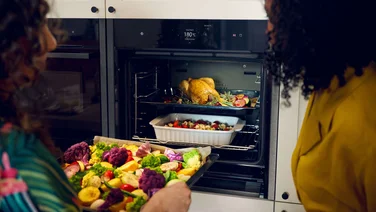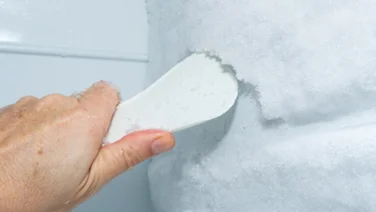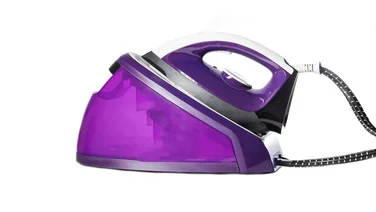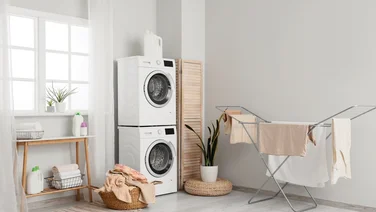To help us provide you with free impartial advice, we may earn a commission if you buy through links on our site. Learn more
























It’s fair to say that washing machines haven’t changed a huge amount over the years, from the outside at least. Every washing machine review we’ve ever done has been on a machine with a front control panel, a drawer where you put the detergent. With the Samsung WW9000 that all changes, as the company full embraces the 21st century and even adds in Wi-Fi and smartphone control to make this the first smart washing machine.
One of the first things you’ll notice about this washing machine is that the front is conspicuosly clear of a detergent drawer. Instead, you poor your entire bottle of detergent into one internal dispenser and the entire bottle of fabric conditioner into another. When you put on a wash, the WW9000 determines how dirty your clothes are and how much softner they’ll need. The washing machine can hold around a month’s worth of cleaning fluids, which means you can just throw your clothes in and start getting the clean without any hassle. If you want to use powder, there’s also a detergent capsule provided with the machine, which you put into the drum with your washing.
Gone is the usual dial and controls, replaced instead with a 5in colour touchscreen. It’s a brilliant addition and makes choosing your wash type really easy, plus you can clearly see on-screen exactly which options you’ve selected. If you find yourself using certain settings a lot, you can just tap the ‘Star’ icon and the WW9000 will add that wash to your list of favourites, where you can quickly recall it next time. With up to four custom wash cycles, there’s enough for most people. Given how much easier the touchscreen makes it to use the washing machine, we’ere a little suprised that it’s not a more common feature.

With the touchscreen taking over the job of setting up the wash cycle, there are only two physical buttons on the machine: a play/pause one and a power button. Of course, the screen shows you the time remaining for your wash.
Samsung WW9000 phone control
One of the most exciting things about the WW9000 is that it’s the first washing machine we’ve seen that can be controlled by your smartphone. To get this feature to work you first of all have to connect the washing machine to your home wireless network. It will connect to any 2.4GHz network and supports all of the common security protocols. Joining a network is fairly straightforward using the control panel, which will list all networks within range, before getting you to enter your password.
Once you’ve got your washing machine online (a Wi-Fi icon appears on the screen to let you know it’s all working), you can remote control it via the Samsung Smart Home app, which is available for Android phones and, later in the year, iPhone smartphones, running iOS 7 (we recommend iOS 7.1). If you’re on the same network as your washing machine, you can simply just remote control it. The app lets you set the wash type, start and pause the machine and view how much time is left on a wash. It’s this latter feature that’s particularly useful, as you don’t have to get up to find out how long’s left before your washing is finished.
If you want to control your washing machine from outside of your home, you have to register your washing machine to your free Samsung account, which you’ll be prompted to create if you don’t have one. Outside of the home, you can do all of the same things that you can from inside. This is pretty clever, as it means that you can just throw your clothes into the machine before, say, you head out to work, without worrying about detergent. Then, when you’re about to leave you can turn your machine on, so you that you arrive to freshly-clean clothes that haven’t been sat in the machine for ages; it’s a better system than using a delay timer, where you still have to guess roughtly when you’ll be home.
We put all of our washing machines through a series of tests to find out how well they clean clothes and how power and water usage differs by mode. Our tests use a 3kg load of clothes for all machines, which means that we can compare results across all machines, regardless of drum size. We started with a standard 30C Cotton wash, where we measured water usage at 32L, and electricity at 0.22kW. That gave us a very-low running cost of 22p per cycle. Moving up to a 40C Cotton wash, there was an increas in running costs, with electricity usage jumping to 0.29kW, although water usage was still consitant at 33L. This gave us an increased, but still impressive cost per cycle of 14p. Both of these cycles show how well the machine can accurately determine how much water a wash needs.
Moving to the 40C Easycare cycle, we saw costs jump to 30p per cycle. This is because water usage increased to 58L, and electricity increased to 0.88kW. This kind of jump isn’t unusual, as the Easycare cycle often has finer and more controlled drum movements, which means that you don’t get such a benefit of momentum, and controlling a drum this large can be tricky. Still, for the size of machine, 30p is a reasonable cost.
Moving to the Super Eco mode, which uses EcoBubble technology to wash clothes at just 20C, we saw the cost per cycle go to 16p. Electricity costs were the lowest that we’d seen, as the water doesn’t really have to be heated, but water usage was comparatively high at 50L.
These kinds of costs are a useful comparison for our clothes, but they don’t fill the machine up, and every washing machine is at its most efficient when it’s full. To get true yearly running costs, we use the manufacturer-provided EU energy label figures. From this we can work out yearly running costs that are comparable across all machines (see how we test washing machines for more information). Using these figures we worked out that the WW10H9600EW costs 23p per cycle to run. Based on our caculations that gave us yearly costs of £37.47 for high usage, £28.10 for medium usage and £18.74 for low usage.
That’s even lower running costs than the impressive 9kg Samsung EcoBubble WF90F7E6U6W. Now the 9kg machine actually has lower per-cycle costs, but the larger 10kg drum of the WW9000 means that it can wash the same amount of clothes using fewer cycles. Again, it shows the importance of really loading up a large machine in order to get running costs down.
Samsung EcoBubble WW9000 wash performance
While cost savings are important, how well a machine washes is also high on our testing agenda. We use strips embedded with common laundry stains to find out how well each of the machines deal with removing them. View our gallery to see all the cleaning examples: dirty cloth is at the top of each sample; the clean one at the bottom.
Cleaning performance was very similar to that of the WF90F7E6U6W, which is to say that performance was very good across the board. The programme you use has an impact on quality, depending on the stain, though. For example, we found the 30C and 40C washes to be generally very good across the board, working well on most stains, although they didn’t get out quite as much of our tough blood stain as we’d have expected, as you can see by the 40C Cotton sample below.

However, the same cycles did a brilliant job on the cocoa stain, getting the bulk of it out of our sample cloth. Moving to our red wine stain, we saw very good results, particulary using the 40C cotton wash, where most of the stain came out. Considering that this is one of the hardest jobs for a washing machine, we were very pleased. You can see the sample strip, using the 40C Cotton wash below.

This is another Samsung washing machine to have the company’s Ecobubble technology. It uses bubbles of air to disolve detergent with air, which is designed to improve cleaning quality at low temperatures. It certainly works well, with the 20C wash the best of the bunch, overall. Using this mode, our tough blood stain was much more evenly attacked, with the bulk of it coming out, as you can see from the sample below. It also put in a great performance across the rest of our stains.

On top of the rest of the technology that has gone into this machine, Samsung has worked hard at making the WW9000 as quiet as possible. It uses Samsung’s VRT-M technology, which has a three-way vibration sensor, which keeps the drum balanced, by spinning 14 ball bearings in the opposite direction. The result is a lot less vibration, cutting out the shudder and thuddering that you get with most washing machines when they spin up and slow down. As a result the washing machine is rated at 72dB during spin and just 46dB when washing. That’s remarkably quiet, particularly for such a load machine. In our lab we didn’t notice any particularly annoying noises or vibrations.
There’s no denying that this is the most technologically advanced washing machine that we have ever seen. The touchscreen makes it incredibly easy to configure, but it’s brilliant that you can also turn it on and operate it from anywhere using your smartphone. We love the new way of dispensing detergent and fabric softner, too, as once you’ve filled up your machine for the month, washing clothese becomes a lot less hassle.
Cleaning performance remains consistent from other Ecobubble washing machines that we’ve reviewed, too, delivering good results at low temperatures. Running costs are also impressive, with some of the lowest yearly costs we’ve seen; however, it’s important that you fill this machine up as much as possible to benefit from these costs, otherwise you’re paying money to move a large drum that you’re not really using.

There’s one thing that’s pretty hard to get away from, though, and that’s the price. This is by far the most expensive washing machine that we’ve ever reviewed. As to whether it’s worth it, it will come down to what you want. If you want the best technology, remote control and the brilliant dispenser, then there’s nowhere else to go and you will absolutely love this machine. If you won’t use the full capacity and can do without the phone control, the older, but still brilliant Samsung Ecobubble WF90F7E6U6W is still available for around £1,000 less.
That said, it’s hard to put a price on technology and with the lack of fiddly controls and its bright touchscreen, the WW9000 isn’t just technologically advanced, it’s also rather fine to look at. For many, that’s enough and this machine firmly deserves its Recommended award.






